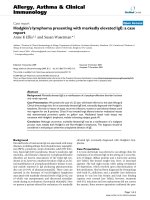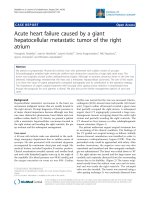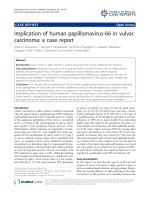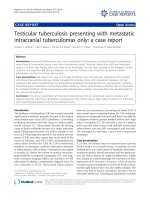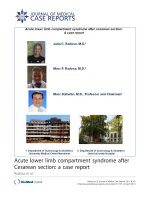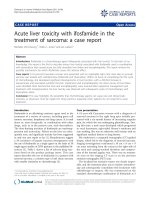Báo cáo y học: "Acute liver failure following hemodialysis arteriovenous graft placement: a case repor" pot
Bạn đang xem bản rút gọn của tài liệu. Xem và tải ngay bản đầy đủ của tài liệu tại đây (255.26 KB, 2 trang )
CAS E RE P O R T Open Access
Acute liver failure following hemodialysis
arteriovenous graft placement: a case report
Zachary Z Brener
1*
, Augusto D Paiusco
1
, Michael Bergman
2
Abstract
Introduction: Severe high-output cardiac failure is a serious complication of high-flow vascular access requiring
immediate intervention. Ischemic hep atitis is defined as a massive increase in serum transaminase levels due to an
imbalance between hepatic oxygen supply and demand in the absence of other acute causes of liver damage. It is
typically preceded by hypotension, hypoxemia, or both, and occurs mostly in elderly patients with right-sided
congestive heart failure.
Case presentation: We report a fatal case of acute liver failure in an 84-year-old Caucasian man with high-output
cardiac failure due to arteriovenous hemodialysis access. The chronological sequence of acute liver failure in the
context of vascular access created two days before suggests that ischemic hepatitis was the result of high-output
cardiac failure due to vascular access.
Conclusions: A thorough car diac assessment should be performed in patients with severe cardiac disease prior to
placing an arteriovenous access, and arteriovenous fistula should be the preferred vascular access.
Introduction
The chronic kidney disease (CKD) population generally
has multiple risk factors and a high prevalence of cardi-
ovascular disease. Thus, it is easy to overlook the contri-
bution of a high-access flow to symptoms of heart
failure in favor of many other possible risk factors.
Severe high-output cardiac failure is a rare, but poten-
tially fatal, complication of high-flow vascular access
requiring immediate intervention [1,2]. It is much more
comm on with prosthetic grafts than with na tive arterio-
venous fistulas (AVF) [3].
Ischemic hepatitis is an infrequent presentation,
usually associated with hypotension, especially in a pre-
sence of right-sided heart failure [4]. This case, to the
best of our knowledge, is the first reported fatal case of
acute liver failure in a patient with high-output cardiac
failure due to arteriovenous hemodialysis access.
Case presentation
An 84-year-old Caucasian man with a history of hyper-
ten sion, cardiovascular disease and diabetic nephropathy
was admitted with progressive dyspnea, abdominal dis-
tention, and pedal edema for one week. Serum K was
6.9 mmol/L, creatinine 300 μmol/L and blood urea nitro-
gen (BUN) 22 mmol/L. His baseline serum creatinine
was 265 μmol/L. His hemoglobin was 98 g/L; interna-
tional normali zed ratio (INR), 1.5; partial thromboplastin
time (PTT) 34.0, and liv er function tests were norma l. A
chest radiograph showed pulmonary congestion. Our
patient was treated with intravenous furosemide resulting
in improvement of congestion and ascites. He remained
normotensive throughout the admission and his serum
creatinine decreased to 221 μmol/L. He was referred to a
vascular surgeon for creation of a permanent vascular
access for hemodialysis. Unfavorable vascular anatomy
precluded AVF creation, and a right upper arm polytetra-
fluoroethylene (PTFE) graft was inserted between the
brachial artery and the proximal brachial vein. After pla-
cement, no complications were noted and our patient
had a palpable thrill. He was discharged home the follow-
ing day. 24 hours later our patient presented with com-
plaints of decreased urine output. Examination showed
blood pressure 75/45 mmHg, clear l ungs, ascites and n o
peripheral edema. His right arm arteriovenous graft had
no palpable thrill. Serum creatinine was 326 μmol/L and
BUN 27 mmol/L. Hemoglobin was 10 g/L; INR, 2.0;
* Correspondence:
1
Department of Medicine, Beth Israel Medical Center, New York, 10003, NY,
USA
Full list of author information is available at the end of the article
Brener et al. Journal of Medical Case Reports 2010, 4:261
/>JOURNAL OF MEDICAL
CASE REPORTS
© 2010 Brener et al; licensee BioMed Central Ltd. This is an Open Access article distributed under the terms of the Creative Commons
Attribution License ( which permits unrestri cted use, distribu tion, and reprodu ction in
any medium, prov ided the original work is properly cited.
prothrombin time (PT), 27.5 s; PTT, 36.5 s; total biliru-
bin, 27.3 μmol/L; AST, 123 unit per liter (U/L); alanine
aminotransferase (ALT), 88 U/L; alkaline phosphatase
(ALP), 121 U/L; lactate dehydrogenase (LDH), 704 U/L.
Chest radiograph was normal and electrocardiogram
(EKG) showed paced rhythm without ischemic changes.
Abdominal ultrasound r evealed ascites, normal gallblad-
der with intra-hepatic and common bile ducts of normal
caliber. Intravenous dopamine, fluids and antibiotics
were started and our patient was admitted to the inten-
sive care unit (ICU). On day two he remained severely
oliguric and hemodialysis was started via internal jugular
catheter. On day three he developed respiratory distress
with fever and was intubat ed. Chest radiograph sh owed
right lower lobe infiltrate. T rans-thoracic echocardio-
gram showed dilated left atrium, infero-septal hypokine-
sia, left ventricular (LV) hypertrophy, moderately
reduced LV function with ejection fraction of 40% and
severe tricuspid regurgitation. His blood cultures were
negative. Our patient’s liver function continued to decline
with total bilirubin rising to 100.9 μmol/L; direct biliru-
bin, 92.3 μmol/L; AST, 445 U/L; ALT, 398 U/L; LDH,
1033 U/L; PT, 31.8 s; PTT, 43 s on the sixth hospital day.
Our patient’s condition deteriorat ed and he died on the
seventh hospital day.
Discussion
Ischemic hepatitis is defined as a massive increase in
serum transam inase levels due to an imb alance between
hepatic oxygen supply and demand in the absence of
other acute causes of liver damage. It is typically pre-
ceded by hypotension, hypoxemia, or both, and occurs
mostly in elderly patients with right-sided congestive
heart failure [4,5]. The chronological sequence of acute
liver failure in the context of vascular access created
two days before suggest that ischemic hepatitis was the
result of high-output cardiac failure due to vascular
access. High-output cardiac failure is defined as symp-
toms of cardiac failure in t he presence of an above-nor-
mal cardiac index (≥ 3.0 L/min/m
2
)[1].Arteriovenous
access creation results in a decreased peripheral resis-
tance and thus increased cardia c output; the higher flow
accesses have a more profound impact on the cardiac
output [1,2]. This complication is more common in
patients with brachiocephalic (elbow) fistulas compared
with radiocephalic (forearm) fistulas, and much more
common with prosthetic grafts than with native AVF
[3]. Elderly patients and those with p re-existing cardio-
vascular disease are at high risk of developing high-
output cardiac failure due to vascular access [3].
Conclusions
A thorough cardiac assessment should be performed in
patients with severe cardiac disease prior to placing an
arteriovenous access, and AVF should be the preferred
vascular access. We suggest that patients with intract-
able or worsening chronic heart failure despite medical
therapy should undergo evaluation for high-output car-
diac failure and may be considered for vascular access
flow reduction or closure.
Consent
Written informed consent was obtained from the
patient’s next of kin for publication of this case report
and any accompanying images. A copy of the written
consent is available for review by the Editor-in-Chief of
this journal.
Author details
1
Department of Medicine, Beth Israel Medical Center, New York, 10003, NY,
USA.
2
Department of Medicine, Hasharon-Golda, Rabin Medical Center,
Petah-Tikva, 19632, Israel.
Authors’ contributions
ZZB was the principal author and was involved in the collection of data,
review of literature, and preparation of the manuscript. ADP and MB were
involved in the collection of literature and in editing the manuscript. All
authors read and approved the manuscript.
Competing interests
The authors declare that they have no competing interests.
Received: 23 October 2009 Accepted: 10 August 2010
Published: 10 August 2010
References
1. MacRae JM, Pandeya S, Humen DP, Krivitski N, Lindsay RM: Arteriovenous
fistula-associated high-output cardiac failure: a review of mechanisms.
Am J Kidney Dis 2004, 43:E17-E21.
2. MacRae JM, Levin A, Belenkie I: The cardiovascular effects of
arteriovenous fistulas in chronic kidney disease: a cause for concern?
Semin Dial 2006, 19:349-352.
3. Dikow R, Schwenger V, Zeiger M, Ritz E: Do AV fistulas contribute to
cardiac mortality in hemodialysis patients? Semin Dial 2002, 15:14-17.
4. Ebert EC: Hypoxic liver injury. Mayo Clin Proc 2006, 81:1232-1236.
5. Seeto RK, Fenn B, Rockey DC: Ischemic hepatitis: clinical presentation and
pathogenesis. Am J Med 2000, 109:109-113.
doi:10.1186/1752-1947-4-261
Cite this article as: Brener et al.: Acute liver failure following
hemodialysis arteriovenous graft placement: a case report. Journal of
Medical Case Reports 2010 4:261.
Submit your next manuscript to BioMed Central
and take full advantage of:
• Convenient online submission
• Thorough peer review
• No space constraints or color figure charges
• Immediate publication on acceptance
• Inclusion in PubMed, CAS, Scopus and Google Scholar
• Research which is freely available for redistribution
Submit your manuscript at
www.biomedcentral.com/submit
Brener et al. Journal of Medical Case Reports 2010, 4:261
/>Page 2 of 2
